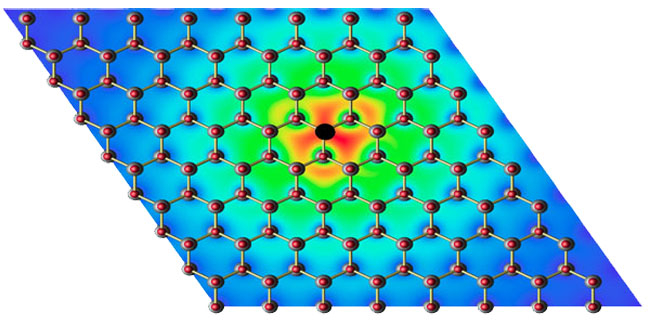Research explores applications for new field of electronics
 (Download Image)
Visualization of the probability of finding an excited electron in zinc-oxide in the vicinity of the hole (indicated by the black dot). In order to understand the exciton in this transparent conducting oxide (TCO), the hole is assumed to be localized at an oxygen atom.
(Download Image)
Visualization of the probability of finding an excited electron in zinc-oxide in the vicinity of the hole (indicated by the black dot). In order to understand the exciton in this transparent conducting oxide (TCO), the hole is assumed to be localized at an oxygen atom.
Postdoc Andre Schleife, who works in the Lab's Quantum Simulations Group, developed a new approach to investigate the interplay of excitonic effects and electron doping. (In semiconductor production, doping intentionally introduces impurities into an extremely pure semiconductor for the purpose of modulating its electrical properties).
These interactions are critical to learning more about transparent conducting oxides (TCOs), which are used in a range of fields including green-energy, intelligent materials or flexible and transparent electronics. Companies like GM, for instance, are currently exploring possible applications for TCOs, such as back seat passenger windows for cars that are displays at the same time. These displays could be used to entertain (games, movies, etc) back seat passengers and also display information about the environment or the city you are driving in.
"Successfully exploiting and eventually tailoring the properties of these unique materials would be analogous to creating 'transparent gold' with a plethora of technical applications," Schleife said. Excitons are the most important pair excitations that occur in several optical spectroscopies of non-metals and molecules and dominate the absorption properties of the TCOs.
While the TCOs are transparent in the visible spectral range (due to large fundamental band gaps), they have to be doped (intentionally or unintentionally) to be conductive. In other words, doping of a semiconductor introduces a large number of free electrons and, therefore, leads to high conductivity.
The field of semiconductor optoelectronics is expected to continue its rapid growth in the future, driven by the demand for efficient photovoltaics or semiconductor lasers for high-bandwidth optical communication.
"The effect of these free carriers on the optical properties is widely unknown," Schleife said. "Dramatic changes are expected in the spectral region, which is the most interesting for applications."
Other researchers include those from Friedrich-Schiller-Universitat in Germany and the European Theoretical Spectroscopy Facility.
The paper appears in Physical Review Letters .
Contact
Anne M Stark[email protected]
925-422-9799
Tags
Physical and Life SciencesScience
Featured Articles







